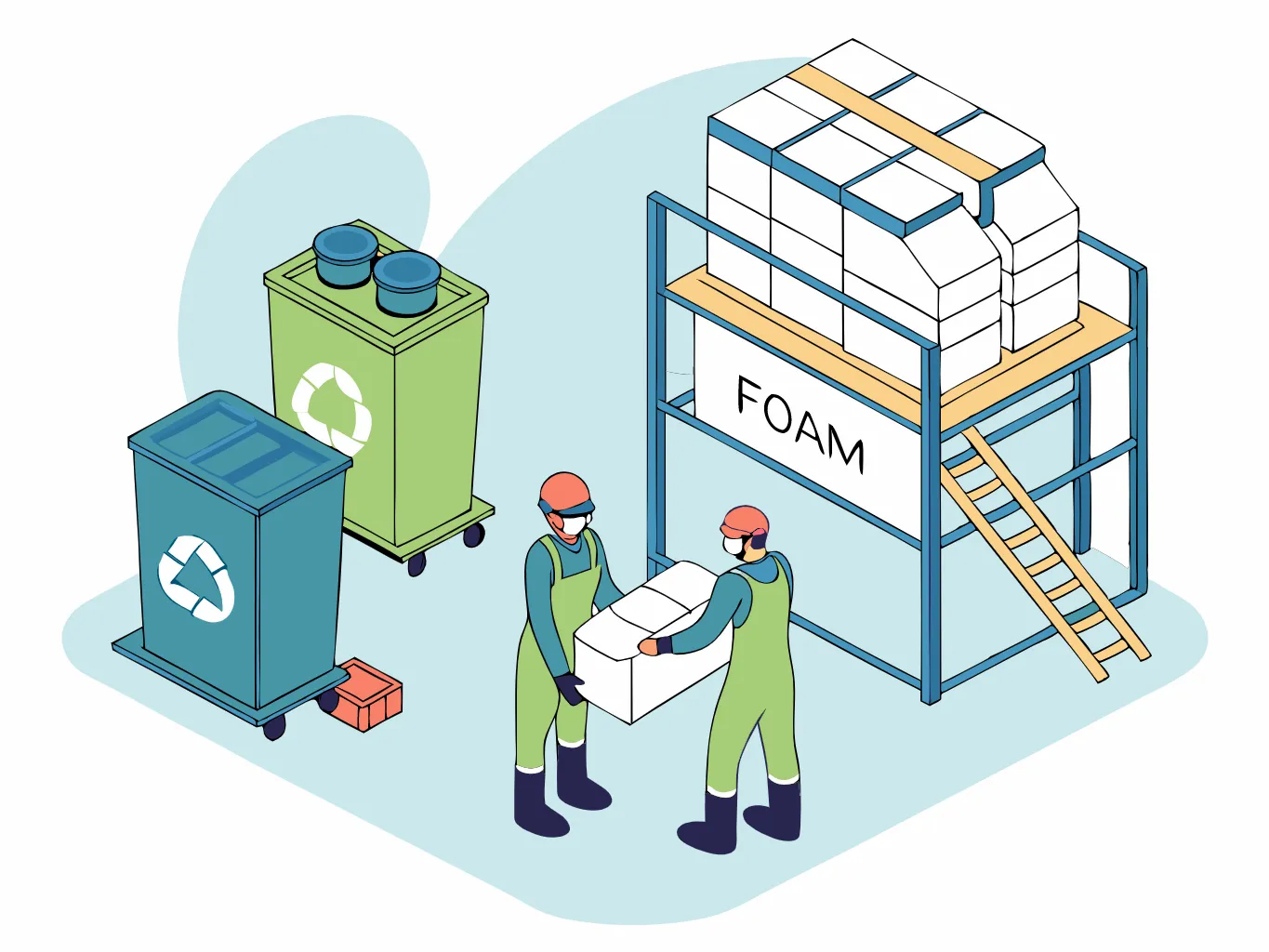Hajlékony hulladék jelentős környezeti kihívást jelent azért, mert nagyobb térfogatú és lassan bomlik le. Fortunáltan mi innovatív megoldást kínálunk, amely a problémás hulladékot értékes, újrahasznosítható anyagokká alakítja. Ez a kimerítő útmutató bemutatja, hogyan működnek ezek a gépek, és miért elengedhetetlenek a fenntartható hulladékkezelés szempontjából., hab újrahasznosító gépek A hab hulladék újrahasznosítási folyamata megértése.
A hab hulladék újrahasznosítása egy gondosan megtervezett sorozat lépéseket tartalmaz, amelyek mindegyike kulcsfontosságú szerepet játszik az összes újrahasznosítási folyamatban.
Gyűjtés és szortírozás: Az hatékony újrahasznosítás alapja.
Az út kezdetén a habanyagok gyűjtése történik üzletekből, újrahasznosítási központokból és gyűjtőpontokból. Ez magában foglalja az expandált polisztirolt (EPS), amelyet gyakran Styrofoamként ismernek, valamint más hab típusokat, amelyeket csomagolásra, hőszigetelésre és fogyasztási termékekre használnak.
A megfelelő szortírozás elengedhetetlen ezen a szakaszban. Az különböző hab típusok különböző feldolgozási módot igényelnek, és a szennyeződések, mint például a celofán, címkék vagy vegyes anyagok jelentősen csökkenthetik az újrahasznosítási hatékonyságot. Az idő befektetése a anyagok megfelelő szétválasztásába biztosítja a simább feldolgozást és a magasabb minőségű kimenetet.
Méretcsökkentés: A nagyobb térfogat kezelhetővé tétele.
Miután szortírozva lett, a hab a daraboló vagy daráló gépekbe kerül, amelyek apróbb darabokra bontják. Ez a lépés megoldja a hab egyik legnagyobb kihívását: az extrém alacsony sűrűségét és nagyobb térfogatát.
A részecske méret csökkentésével ezek a gépek egy egységes anyagot hoznak létre, amely könnyebben kezelhető a következő feldolgozási szakaszokban. A kisebb részecskék lehetővé teszik a jobb összenyomási arányokat a sűrítési szakaszban, ami végül javítja az egész újrahasznosítási művelet hatékonyságát.
By reducing particle size, these machines create a more uniform material that’s easier to handle in subsequent processing stages. Smaller particles also allow for better compression ratios during densification, ultimately improving the efficiency of the entire recycling operation.
Duzzasztás: A Kritikus Tranzició
A duzzasztás a hab szennyezés újrahasznosításának szíve. Hab újrahasznosító gépek Használjon speciális összenyomókat vagy duzzasztókat, amelyek hő és nyomás alkalmazásával jelentősen csökkentik a hab mennyiségét – gyakran 90% vagy ennél többet.
Néhány gép hőmérsékleti módszereket alkalmaz, kontrollált hő alkalmazásával puhítja és összenyomja a habot. Mások mechanikai összenyomást használnak, erős hidraulikus rendszerek segítségével összenyomják a anyagot sűrű blokkokká. Ez a transzformáció teszi a hab újrahasznosítását gazdaságilag lehetségesnek, mivel csökkenti a tárolási helyigényt és a szállítási költségeket akár 50-szer is.
Kivonatolás: Nyersanyagok Létrehozása a Gyártáshoz
Polisztirol hab és bizonyos más típusok esetében az extrudálás továbbviszi az újrahasznosítást. Ezek az előrehaladott gépek megolvasztják a összenyomott habot, és speciális formákon keresztül kényszerítik át, így egységes műanyag granulátumokat vagy egyedi profilokat hoznak létre.
A kapott granulátumok megfelelnek a gyártási alkalmazások specifikációinak, lehetővé téve, hogy őket új termékek alapanyagaként használják. Ez a folyamat lényegében visszahozza a habot az eredeti nyersanyag formájába, készen állva új életciklusának kezdetére.
Kimenet és Újrahasznosítás: A Ciklus Zárása
A hab újrahasznosításának végső kimenete több formában is létezik, mindegyiknek megvan a saját alkalmazása:
Duzzasztott blokkok vagy ingók Műanyag granulátumok építési projektekben, zajszigetelő alkalmazásokban és szállító konténerekben használt könnyű töltőanyagként, valamint távolságtartóként. Az egyenletes sűrűségük és alakjuk miatt könnyen kezelhetők és szállíthatók.
Műanyag granulátumok az új termékek alapját képezik, beleértve a képfalakat, csúszkát, irodai felszereléseket, és akár új habtermékeket is. Sok gyártó aktívan keresi a újrahasznosított hab granulátumokat a prémium alapanyagok fenntartható alternatívaként.
Testreszabott extrudált profilok specifikus alkalmazásokhoz közvetlenül létrehozhatók, így elkerülhetők a további gyártási lépések, és csökkenthető az általános gyártási költségek.
Habszilárdító berendezések típusai
Az különböző géptípusok megértése segíti a vállalkozásoknak abban, hogy kiválasszák a megfelelő berendezést igényeikhez.
Szakaszolók és darabolók
Ezek a gépek kizárólag a méretcsökkentésre specializálódnak és általában a nagyobb újrahasznosítási műveletek első lépéseként szolgálnak. Ideálisak azok a létesítmények számára, amelyek nagy mennyiségű vegyes hab hulladékot dolgoznak fel.
tömörítőgépek
Kompaktorok mechanikai nyomással csökkentik a hab mennyiségét anélkül, hogy megolvadna. Ideálisak azok a vállalkozások számára, amelyek rendszeresen generálják a hab hulladékot, de nincs helyük teljes újrahasznosítási vonalaknak. A kompaktozott anyagot aztán szállíthatják olyan létesítményekhez, amelyek rendelkezenek fejlettebb feldolgozó berendezésekkel.
Sűrítők
Densifikátorok hő és mechanikai nyomás kombinációjával rendkívül sűrű blokkokat vagy öntvényeket hoznak létre. Ezek a gépek nagyobb összenyomási arányt biztosítanak, mint a hideg összenyomók, és a termék könnyebben tárolható és hosszú távú szállításra is alkalmas.
Extruderek
Keverők az egyik legfejlettebb habújavítási technológia képviselői, amelyek a anyagot olvasztják és újraformázzák granulátumokká vagy profilokká, amelyek már a gyártásra készülnek. Bár nagyobb előzetes befektetést igényelnek, a legmagasabb értékű kimenetet biztosítják, és elengedhetetlenek azok számára, akik zárt körű hulladékgyűjtési rendszereket szeretnének létrehozni.
Miért fontos a habújavítás?
Környezetvédelem
A habújavítási hulladék óriási helyet foglal el a szeméttelepeken, és több száz éven át is fennmaradhat anélkül, hogy leépülne. A habújavítás révén jelentősen csökkenthetjük a hulladék mennyiségét, amely el kell távolítani, és megelőzhetjük, hogy káros anyagok halmozódjanak fel környezetünkben.
Erőforrás-megőrzés
Minden megújított habújavítási tonna csökkenti a prémium kőolaj-alapú polimerek iránti keresletet. Ez végtelen természeti erőforrásokat takarít meg, és csökkenti az alapanyagok kitermelése és feldolgozása körül fellépő környezeti terheket.
Gazdasági lehetőségek
A hulladékgyűjtés létrehozhatőségi gazdasági értéket. A vállalkozások bevételt termelhetnek az anyagokból, amelyeket korábban hulladékkezelési költségekkel fizettek ki. A megújított habújavítási piac folyamatosan növekszik, és egyre nagyobb keresletet tapasztalnak a fenntartható anyagok kereső gyártók részéről.
Támogatja a zárt körű gazdaság céljait
Hab újrahasznosító gépek segítenek a vállalkozásoknak áttérni a lineáris “felvenni-gyártani-eltudni” modellekről a körkörös rendszerekre, ahol az anyagok folyamatosan ciklusznak a használat, a helyreállítás és a újratermelés során. Ez az eljárás összhangban áll a globális fenntarthatósági kezdeményezésekkel és egyre szigorúbb környezetvédelmi előírásokkal.
Az implementáció kulcsfontosságú megfontolásai
Berendezések kiválasztása
Válassza ki a berendezéseket a specifikus hab típusok, feldolgozási mennyiség és térbeli korlátok alapján. Gondolja át, hogy egyetlen gépre vagy integrált hulladékkezelési vonalra van szüksége, és értékelje mind a berendezési költségeket, mind a hosszú távú működési hatékonyságot.
Személyzet képzése
A megfelelő képzés biztosítja a biztonságos és hatékony működést, valamint maximalizálja a berendezések élettartamát. Az operátoroknak meg kell érteniük a szedési követelményeket, a biztonsági protokollt és az alapvető hibakeresési eljárásokat.
Rendszeres karbantartás
Hozzon létre megelőző karbantartási ütemtervet a gépek zökkenőmentes működéséhez. A rendszeres tisztítás, kenés és ellenőrzés megelőzi a költséges meghibásodásokat és biztosítja a folyamatos kimeneti minőség egyenletesét.
Minőségellenőrzés
Hozzon létre eljárásokat a kimeneti minőség ellenőrzésére. Az egyenletes sűrűség, a minimális szennyezés és a megfelelő méret biztosítja, hogy a újrahasznosított anyagok megfeleljenek a piaci előírásoknak és magas áron értékesíthetők legyenek.
Gyakran ismételt kérdések
Milyen típusú habot lehet újrahasznosítani ezekben a gépekben?
Többnyire hab újrahasznosító gépek kezelik az EPS (bővült polisztirol), az XPS (extrudált polisztirol) és a polietilén habot. Minden géptípus specifikus képességekkel rendelkezik, így fontos, hogy az eszközöket a hab típusához igazítsák. Néhány előrehaladott rendszer több habfajtát is képes feldolgozni, míg mások specifikus anyagokra specializálódnak a legnagyobb hatékonyság érdekében.
Mennyi helyre csökkentheti a hab újrahasznosítási gépek a mennyiséget?
A modern hab újrahasznosítási berendezések általában 90-98% mennyiségre csökkentik a hab mennyiségét, a géptípus és a feldolgozási módszer függvényében. A hideg tömítők általában elérnek 40:1 és 50:1 összehajtási arányt, míg a melegolvasztó tömítők és extruderek elérhetik a 90:1 arányt vagy ennél nagyobbat. Ez a jelentős csökkentés gazdaságos tárolást és szállítást tesz lehetővé.
Milyen az ROI idővonal a hab újrahasznosítási berendezésekbe történő befektetés esetén?
A befektetési megtérülés a hab hulladék mennyiségétől, a berendezési költségektől és a helyi piaci körülményektől függően változik. Az jelentős hab mennyiséget feldolgozó vállalkozások gyakran 1-3 éves megtérülési időszakot tapasztalnak a hulladék eltávolítási költségek csökkentése és a újrahasznosított anyagok eladásából származó bevétel révén. A kisebb működéseknél hosszabb idő alatt is pozitív megtérülést érhetnek el.
Mérheti-e a újrahasznosított hab a szennyezett anyag minőségét?
Igen, a megfelelően feldolgozott újrahasznosított hab sok alkalmazásban megfelelhet a szennyezett anyag minőségének. A kulcs a megfelelő szedés, szennyezés ellenőrzése és a feldolgozási paraméterek. Bár néhány magas specifikációs alkalmazás még mindig szennyezett anyagot igényel, az újrahasznosított hab kiválóan használható építőanyagokban, új csomagolásban, fogyasztási termékekben és sok gyártási alkalmazásban.
Milyen a hab újrahasznosítási gépek fő üzemeltetési költségei?
Az üzemeltetési költségek az elektromosság (a legnagyobb változó költség), a karbantartási alkatrészek, a munkaerő és az időnkénti javítások. Az energiahatékony modellek csak néhány centet igényelnek a fontra. A rendszeres megelőző karbantartás minimalizálja az váratlan javítási költségeket. A legtöbb vállalkozás megtalálja, hogy az üzemeltetési költségek meghaladják a hulladék eltávolítási megtakarításokat és az anyag eladásából származó bevételt, így a hab újrahasznosítása idővel rendkívül gazdaságos.



